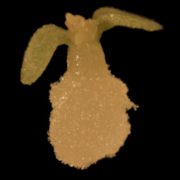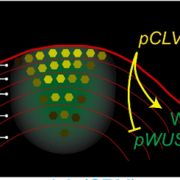Plant stem cells under low oxygen: metabolic rewiring by phytoglobin underlies stem cell functionality
 When flooding occurs, soils become saturated and oxygen solubility and diffusion decreases. This situation creates a hypoxic environment in the roots that stresses the plant, causing significantly decreased growth. However, the quiescent center (QC) stem cells, located in the root apical meristem, are highly hypoxic under normal oxygen tension. When hypoxia is imposed to the roots, QC stem cells become vulnerable, causing their degradation. The effects of the QC degradation have been ascribed to the accumulation of nitric oxide (NO), since overexpression of phytoglobins (Pgb) (which scavenge NO) preserved the functionality of the QC cells. In this work, Mira et al. described carbon/nitrogen metabolism in the QC stem cells under low oxygen. To study this, they dissected maize QC stem cells and conduced multi-omic analysis. These analyses shed light into how the QC cells are metabolically, proteomically, and transcriptomically reprogrammed in response to hypoxia. This work demonstrates that root stem cells are vulnerable to low oxygen stress and the preservation of QC stem cells is linked with engagement of the TCA cycle and the action of a phytoglobin-encoding gene ZmPgb1.1 and the retention of carbohydrates and starch. (Summary by Eva Maria Gomez Alvarez, @eva_ga96) Plant Physiology. 10.1093/plphys/kiad344
When flooding occurs, soils become saturated and oxygen solubility and diffusion decreases. This situation creates a hypoxic environment in the roots that stresses the plant, causing significantly decreased growth. However, the quiescent center (QC) stem cells, located in the root apical meristem, are highly hypoxic under normal oxygen tension. When hypoxia is imposed to the roots, QC stem cells become vulnerable, causing their degradation. The effects of the QC degradation have been ascribed to the accumulation of nitric oxide (NO), since overexpression of phytoglobins (Pgb) (which scavenge NO) preserved the functionality of the QC cells. In this work, Mira et al. described carbon/nitrogen metabolism in the QC stem cells under low oxygen. To study this, they dissected maize QC stem cells and conduced multi-omic analysis. These analyses shed light into how the QC cells are metabolically, proteomically, and transcriptomically reprogrammed in response to hypoxia. This work demonstrates that root stem cells are vulnerable to low oxygen stress and the preservation of QC stem cells is linked with engagement of the TCA cycle and the action of a phytoglobin-encoding gene ZmPgb1.1 and the retention of carbohydrates and starch. (Summary by Eva Maria Gomez Alvarez, @eva_ga96) Plant Physiology. 10.1093/plphys/kiad344











